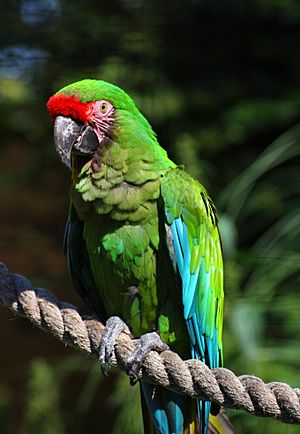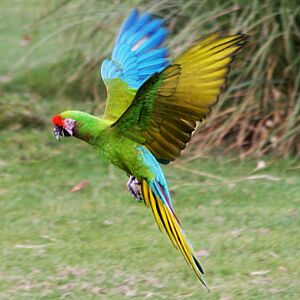Military macaw facts for kids
Quick facts for kids Military macaw |
|
|---|---|
 |
|
| A military macaw at the London Zoo | |
| Conservation status | |
| Scientific classification | |
| Genus: |
Ara
|
| Species: |
militaris
|
 |
|
| Distribution of the 3 subspecies of military macaw | |
| Synonyms | |
|
Psittacus militaris Linnaeus, 1766 |
|
The military macaw (Ara militaris) is a medium-sized macaw known for its bright green and red plumage. People say its colors look a bit like a military uniform, which is how it got its name! These birds live in the wild from Mexico all the way south to northern Argentina and Bolivia.
Even though you can often see military macaws in zoos and parks around the world, their wild populations are facing challenges. The IUCN lists them as vulnerable, and in Mexico, they are considered endangered. Luckily, these macaws can be bred fairly easily in captivity. They are also one of the longest-living birds you can own, but they need a lot of care and knowledge to stay healthy and happy.
Contents
About the Military Macaw's Name
The military macaw was officially named in 1766 by a Swedish scientist named Carl Linnaeus. He first called it Psittacus militaris. Later, in 1799, a French scientist named Bernard Germain de Lacépède placed it in the group (or genus) called Ara.
The name Ara comes from the Tupi word ará, which means "macaw." It also sounds like the loud squawking noises these birds make! The second part of its name, militaris, is a Latin word that means "military."
There are three different types, or subspecies, of the military macaw:
- A. m. mexicanus: Found in western Mexico.
- A. m. militaris: Lives in Colombia, northwestern Venezuela, Ecuador, northern and southeastern Perú, and northwestern Bolivia.
- A. m. bolivianus: Found in central Bolivia and northwestern Argentina.
What Military Macaws Look Like
Military macaws are quite large birds, usually measuring about 70 to 85 centimeters (27.5 to 33.5 inches) long. Their wings can spread out to about 99–110 cm (33–43 inches)!
Most of their body is bright green. They have light-blue and yellow feathers on their wings and tail. You'll also notice a bright red patch on their forehead. Like many macaws, their face has no feathers and is whitish with thin black lines. Their strong, large bill is a dark gray or black, and their eyes are yellow.
These macaws look a lot like great green macaws. However, military macaws are a bit smaller and have a completely black bill. Their green feathers are also a darker shade. You can also tell them apart by their different calls. Military macaws usually live in deciduous forests, where trees lose their leaves, while great green macaws prefer humid forests.
The different subspecies of military macaws also vary in size and color. The militaris subspecies is the smallest, and the mexicana subspecies is the largest.
Military Macaw Behavior
Military macaws often live in large groups called flocks. In the wild, they can live for a very long time, sometimes up to 50 or 60 years! You can usually hear them before you see them because they are very noisy birds. They make many loud sounds, including a strong "kraa-aak!" They are most active in the morning and evening.
Food and Feeding Habits
Around sunrise, military macaws leave their roosting spots in flocks to find food. Their diet mainly consists of seeds, but they also eat fruits and leaves. They have been seen drinking water from certain plants and even eating latex from some trees. They tend to eat only a small variety of plants that are available to them.
Sometimes, they gather at special places along riverbanks or in the Amazon rainforest called "macaw licks." These are heaps of clay that the macaws eat. Scientists believe the clay helps remove toxins from the seeds and plants they eat. It also provides them with important salt that might be missing from their regular diet.
Reproduction and Life Cycle
Military macaws show their affection by grooming each other and sharing food. These behaviors happen during both breeding and non-breeding times. Courtship, which is when they try to attract a mate, can start as early as March. Mating usually happens from May to July.
The breeding season is typically between March and October. The female lays her eggs, and the chicks hatch during August and September. The whole process, from choosing a nest to the young birds leaving the nest, lasts from October to March.
Military macaws build their nests in natural holes, like those found in tall trees or on cliffs. They choose trees that are at least 15 meters (about 49 feet) tall and 90 centimeters (about 3 feet) wide. During the breeding season, the male macaw will feed the female several times a day.
Where Military Macaws Live

Military macaws usually live in tropical forests where trees lose some or all of their leaves. They are "canopy species," meaning they spend a lot of time in the tops of tall trees. These tall trees provide them with food, places to breed and nest, and protection from predators and the heat.
They typically live in mountains at elevations of 600 to 1500 meters (about 2,000 to 5,000 feet). This is higher than most other macaws usually go! However, during certain times of the year, they might fly down to lower areas. There, they can be found in humid forests or thorny woodlands. They often nest in the very tops of trees or on cliff faces that are more than 200 meters (about 600 feet) high.
The three different types of military macaws live in different parts of the world:
- A. m. militaris is found in Bolivia, Peru, Ecuador, Colombia, and Venezuela.
- A. m. mexicana lives in Mexico.
- A. m. boliviana is found in Bolivia and Argentina.
Sometimes, military macaws escape or are set free in places like Florida, USA. However, there's no proof that these birds are breeding there. They might only be around because more birds keep escaping or being released.
Protecting Military Macaws
Scientists estimate that there are only about 2,000 to 7,000 military macaws left in the wild that can breed, and this number is still going down. The IUCN lists them as "vulnerable." This means they are at risk because their homes are being destroyed. This happens due to things like farms, deforestation (cutting down forests), mining, and new roads. Their populations are already split into very small, separate groups. A study in 2013 found that nearly 32% of their tropical dry forest habitat has been lost.
Military macaws are also listed under CITES Appendix 1. This means it's against the law to buy or sell wild military macaws internationally. Even with these rules, research shows that parrots are still illegally moved from South America to North America.
Their specific diet is another worry. If something happened to their environment and they lost access to the plants they usually eat, it could greatly affect the species. However, there's hope because they eat a wider variety of foods during certain times of the year. This suggests they might be able to adapt if their usual food sources disappear.
Another concern for military macaws is their genetic diversity. Even though their population is small, they actually have a moderate amount of genetic variety. This suggests that their ancestors were once a very large population. Still, they are at risk of problems like inbreeding and losing more genetic diversity because their habitats are broken up into small pieces.
Gallery
-
Eating at Disney's Animal Kingdom, Florida
-
Resting in the Tropical Zone of the Montreal Biodome
-
Cougar Mountain Zoo Issaquah, WA









